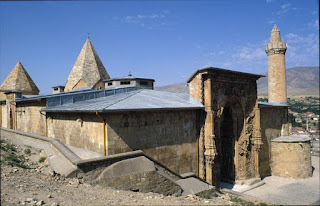Approximately
40 kilometers from South of Cairo, a beautiful Bent Pyramid located at the
royal necropolis of Dahshur. This is unique marvel in the area, and popular
tourist destination as well. It is so called one of unusual pyramids of ancient
Egypt, famous for numerous pyramids. This specific pyramid was fairly popular
due to outside archaeological circles, however there as an army camp adjacent
and restricted no go area. The Pyramid eventually brings into being with a very
steep angle of 54 degrees but halfway through construction the builders
comprehended that the angle was too steep. Therefore, the upper half was
completed at a shallower angle of 43-degrees to avoid the structure from
collapsing. This reason gives the Pyramid a “bent” appearance leading to its
modern name.
It is
strongly believed that the Bent Pyramid was the first Egyptian pyramid intended
by its builders to be a "true" smooth-sided pyramid from the outset.
Previous pyramids were either stepped, or first built as stepped and later filled
in to make a smooth outer casing. The “Bent Pyramid” also boasts of being the
only pyramid to have its unique polished limestone outer casing largely intact.
Numerous Egyptian pyramids, including the “Great Pyramid of Giza”, at first had
a smooth outer casing of highly polished white limestone that must have be
skilled at dazzlingly under the desert sun. Nevertheless, these were stripped
away during far ahead generations and carted off to build other structures
around Egypt. Moreover, the blocks of stones we see these days on the pyramids
are actually core structure. On the “Bent Pyramid”, the outer casing is still
noticeable which helps to show how the ancient Egyptians intended their
pyramids to look, though it has lost its shine and parts of it are crumbling
away. The Bent Pyramid is distinctive in having two entrances. The first
entrance is on the north face around twelve meters above ground level, while
the second entrance is on the west face around one meter marginally above
ground level.
The Pyramid
was commissioned by “Sneferu”, who was the father of “Khufu”, who commissioned
the Great Pyramid of Giza. Therefore, Snefru’s first major undertaking was the
Pyramid at Meidum which was originally began by his father King Huni. Though,
Sneferu never finished the pyramid. Though, it was believed that the Meidum
Pyramid had partially malformed during construction and was consequently
abandoned. Sneferu then moved his capital to “Dahshur” where he started
constructing his second pyramid, the Bent Pyramid. Sneferu’s third and his last
pyramid stand around one kilometer to the north of the Bent Pyramid. Which is called “Red Pyramid” or the “North
Pyramid” actually the largest and the most effective of the three. So as the
time goes, he learned from his past mistakes, Sneferu ordered the Red Pyramid
to build at the same shallow 43 degree angle as the upper section of the Bent
Pyramid, which gave the pyramid a noticeably squat appearance compared to other
Egyptian pyramids of comparable scale. The Red Pyramid was the first
productively completed smooth-sided pyramid of Egypt, a project that was later
adopted by numerous of his successors including his son Khufu, when he built
the magnificent “Great Pyramid of Giza”.























































